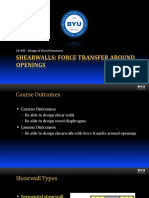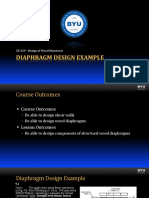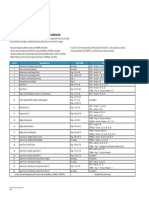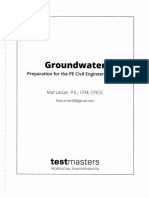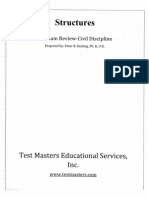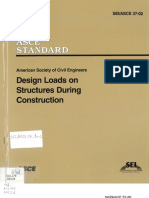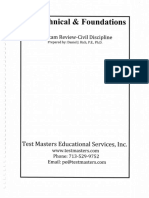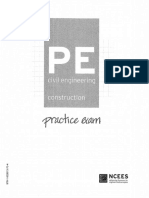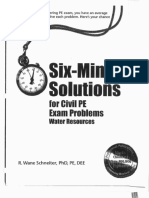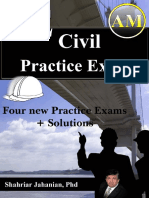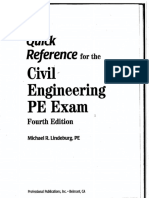Professional Documents
Culture Documents
Awwa C222 PDF
Uploaded by
nick100%(1)100% found this document useful (1 vote)
1K views33 pagesOriginal Title
AWWA C222.pdf
Copyright
© © All Rights Reserved
Available Formats
PDF or read online from Scribd
Share this document
Did you find this document useful?
Is this content inappropriate?
Report this DocumentCopyright:
© All Rights Reserved
Available Formats
Download as PDF or read online from Scribd
100%(1)100% found this document useful (1 vote)
1K views33 pagesAwwa C222 PDF
Uploaded by
nickCopyright:
© All Rights Reserved
Available Formats
Download as PDF or read online from Scribd
You are on page 1of 33
\.
American Water Works
Association
ANSI/AWWA C222a-09
Addendum to
ANSI/AW WA C222-08
Standard
for
Polyurethane Coatings for the Interior and
Exterior of Steel Water Pipe and Fittings
Approved by AWWA Board! of Directors June 14, 2009.
‘Approved by American National Standards Institute Sept. 17, 2009.
1, Table1 Properties of laboratory applied coating, add the following:
Property Requirement ‘Test Method
Adhesion to Steel (ASTM D4541) 1,500 psi (10,350 kPa), x
2. Sec. 4.2, add the following new section:
42.9 Adhesion. The adhesion of the coating system to che steel shall be
desermined in accordance with ASTM D4541. The adhesion of the coating system.
shall be a miniraum of 1,500 psi (10,350 KP).
CCopytght © 2008 American Water Werks Assocation. Al Rights Reserved
ANSI/ AWWA C222-08
A (Revision of ANSY/AWWA 6222-29)
American Water Works
Association
‘The Authoritative Resource on Safe Waters
AWWA Standard
Polyurethane Coatings
for the Interior and
Exterior of Steel Water
Pipe and Fittings
A\._ | STANDARD
SER | Since 1881
Effective date: Dec. 1, 2008.
Fist edition approved by AWWA Board of Directors June 20, 1999.
This edition approved June 8, 2008.
‘Approved by American National Standards Institute Sept. 17, 2008.
665 West Quincy Avenue
emer, co 80353098 ‘communications
"700.926.7237 Conferences
nana org Eaveaton and Tring
‘Science and
Sections
panini
AWWA Standard
This document is an Amecan Water Works Assocation (AWWA) standard tI not specication. ANWA standards
sorte minknum requlements and do not contain all of the engineering and scminisvstve Information normally
contained in specications. The AVA standards usual contain optons that must be evaluated by the user ofthe
standard, Uni each optional feature Is spected by the user, the procuct or sore Ts not fully dared. AMA
ubicaton of standard does not constitute entorserent of ary product or procuct type, nor does ANA tes, cert,
Oc approve ery product. The use of AWWA standards is eniely voluntary. This standard does not supersede o tke
precedence over or clplace any appcabe tw, reguaion oF codes of ary governor author. AWWA standards
{are Inended to represent consensus of the water supply indus that te product desorbed wil provide satsfacory
‘service. When ANA revises oF witrens tis stander, an offal nace of action wl ke placed on te fst page of
the classified advertising section of Jove’ AW, To action bacomes elective or the Fst day ofthe mont folowre,
‘the month of Joust AIA publication ofthe oficial notice.
American National Standard
‘An Avercan Natenal Standard implies 2 consereus of those substamialyconeomed with ks eeope and provilons. An
American Nateral Stara i intended as a gude to ad the manufactur, the consume, an th general pul. The
‘existence of an American National Standard does not in any respect prechde anyone, whether that person has
approved te stancar orn, fom manufacturing, merating, purchasing, oF using products, prozesees, or procedies
‘at conforming to the standard. American National Stancars are suect to period review, and users se cautoned
to obtain the latest ociians. Producers of goeds made In conformity with sn Amedean National Stendare ae
‘encouraged to state on thelr onn responsibly in acvertsing and premtionsl materia oon tags of abels tat the
00d are produced in conformity with partclarAmercan National Stender.
‘Cuno Nonce: The American National Standards Institute (ANSI) approval dato on the front cover of tis standard
Indicates competion ofthe ANSI aporoval process. This American National Standard may be revised or wthawn at
ary time. ANSI procedures requre Wat action be taken to vat, ese, of withiaW the standart no late tan THe
Years fom the date of publication. Purchasers of Amercan National Standards may recahe cent Information on all
‘Standard by cali or wring the Amrican National Standards Intute, 25 West 43ré See, Fourth Foor, Now Yr,
NY 10086; (212) 642-4900.
‘nti reserved. No part ofthis publication maybe reproduced or uansmitted in ary form or by any means, electronic
fr machanica, ncliding photocopy, recorcng, or any Information of retrieval system, except In the form of bef
‘excepts or quotations fr revlew purposes, without the witan permission ofthe publisher.
\Copyigt © 2008 by American Vater Works Association
Primed in USA
‘otal arto ae setereetneere
Committee Personnel
‘The SWPMTAC Task Group on C222, which developed this edition, had the following
personnel at the time:
Antonio Liberatore, Chair
ED. Barnes, Barnes Group International, Windsor, Calif.
M. Bauer, Tnemec Company, Inc., North Kansas City, Mo.
RM, Buchanan, Canusa-CPS, Toronto, Ont.
RW, Geary, Tek-Rap Inc., Houston, Texas
B.D. Keil, Continental Pipe Manufacturing, Pleasant Grove, Utah
‘A. Liberatore, Madison Chemical Industries Inc., Milton, Ont.
L. McKinney, Womble Company Inc., Houston, Texas
RD. Mielke, Northwest Pipe, Raleigh, N.C.
RE, Newby, ICI Devoe Coatings, Mandeville, La.
J. O'Brien, Tapecoat Company, Evanston, Il
S.R Scarpone, Reilly Industries Inc., Indianapolis, Ind.
MSS. Soloninka, ShawCor Pipe Protection, Houston, Texas
J.A. Wise, Canus International Sales Inc., Surrey, B.C.
cawway
(AWWA)
(awwa)
(awwa)
(SPFA)
(AWWA)
(awwa)
(AWWA)
(AWWA)
(aww)
(Awa)
(AwvWA)
(AWWA)
‘The AWWA Standards Committee on Steel Pipe, which reviewed and approved this stan-
dard, had the following personnel at the time of approval:
John H. Bambei Jr., Chair
George J. Tupac, Vice-Chair
Dennis Dechant, Secretary
General Interest Members
J.B. Allen,” Standards Engineer Liaison, AWWA, Denver, Colo.
W.R. Brunzell, Brunzell Associates Led., Skokie, Ill
RL. Coffey, HDR Engineering Inc., Omaha, Neb.
HLE. Dunham, MWH Inc., Bothell, Wash,
S.N. Foellmi, Black & Veatch Corporation, Irvine, Calif.
(AWWA)
(AWWA)
(AWWA)
(AWWA)
(awwa)
JAW. Green, McDonough Associates Inc., Chicago, Il
MLB. Horsley,” Black & Veatch Corporation, Kansas City, Mo,
JAK. Jeyapalan, Pipeline Consultant, New Milford, Conn.
JL. Mattson, Corrosion Control Technologies, Sandy, Utah
‘WJ. Moncreif,” HDR Engincering Inc., San Diego, Calif.
R. Ortega, Lockwood Andrews & Newman, Houston, Texas
AE. Romer, Boyle Engineering Corporation, Newport Beach, Calif.
H.R. Stoner, Consultant, North Plainfield, NJ.
CC. Sundberg, CH2M Hill Inc, Issaquah, Wash.
GJ. Tupac, G.J. Tupac & Associates Inc., Pitsburgh, Pa.
WAR. Whidden, Post Buckley Schuh & Jernigan, Orlando, Fla.
KE. Wilson,* Standards Council Liaison, Post Buckley Schuh & Jernigan,
Tampa, Fla
Producer Members
S.A. Arnaout, Hanson Pressure Pipe Inc., Dallas, Texas
HLH. Bardakjian, Consuleant, Glendale, Calif.
'M. Bauer, Tnemec Company Inc., North Kansas City, Mo.
RJ. Card, Victaulic, Adanta, Ga,
RR. Carpenter, American Spiral Weld Pipe Company, Birmingham, Ala.
D. Dechant, Dechant Infrastructure Services, Aurora, Colo.
'W.B. Geyer, Street Plate Fabricators Association, Lake Zurich, Ill.
J.L. Laka,” American SpiralWeld Pipe Company; Columbia, 8.C.
R. Mielke,’ Northwest Pipe Company, Raleigh, N.C.
J. Olmos, Ameron International, Rancho Cucamonga, Calif.
B, Vanderplocg, Northwest Pipe Company, Portland, Ore.
J.A. Wise, Canus International Sales, Surrey, B.C.
User Members
G.A. Andersen, New York City Bureau of Water Supply, Little Neck, N.Y.
J.H. Bambei Jr., Denver Water Department, Denver, Colo.
*Akernate
+ Linison, nonvoting
‘sitar oer ee tne ‘seteneay err
(awwa)
(awwa)
(AWA)
cawwa)
(AWWA)
(awwa)
(awwa)
(AWWA)
(AWWA)
(awwa)
(AWWA)
(AWWA)
(AWWA)
(AWWA)
(awwa)
cawwa)
(Mss)
(AWWA)
(SPFA)
(AWWA)
(AWWA)
(AWwWa)
(awwa)
cawwa)
(Awwa)
(AWWA)
D.W, Coppes, Massachusetts Water Resources Authority,
Southborough, Mass.
RAV. Frisz, US Bureau of Reclamation, Denver, Colo,
G. George, Tacoma Water, Tacoma, Wash.
T]. Jordan, Metropolitan Water District of Southern California,
La Verne, Calif.
M, McReynolds,” Metropolitan Water District of Southern California,
LaMirada, Calif
G. Oljaca, Greater Vancouver Regional District, Burnaby, B.C.
VB. Soto, Los Angeles Department of Water & Power, Los Angeles, Calif.
GB Stine, San Diego County Water Authority, Escondido, Calif.
J.V. Young, City of Richmond, Richmond, B.C.
(NEWWA)
(USBR)
(AWWA)
(AWWA)
(AWWA)
(AWWA)
(AWWA)
(AWWA)
(AWWA)
‘This page intentionally blank.
Contents
{ AILAWWA standards follow the general format indicated subsequently. Some uariations from this format
‘may be found in a particular standard.
see, PAGE SEC. PAGE
i Foreword 45 Coating Application. 8
{ I Introduction. 4.6 — Coating Repai 10
} LA Background. 4,7 Welded Field Joints n
| 1B His 4.8 Nonwelded Joints.
! Lc 49 Coating Special Pipe Connections
| MH Special Issues. and Appurtenances ..
i II Use of This Standard. ead roan
i TILA Purchaser Options and 4.11 Safety and Regulations... “4
| panies * § Verification
LLB Modification to Standar xi
oe a FL Quality Assurance and Records.
Ree eeancaee xij 32 Purchasers Inspection.
5.3 Laboratory-Applied Coating
‘System Requirements.
5.4 Surface Preparation Inspection
5.3 Shop- or Field-Coated Pipe
Inspection ....
5.6 Notice of Nonconformance
6 — Delivery
a 61 General
3 6.2 Packaging.
a 6.3 Storage of Materials
64 Affidavit of Compliance..
4l Materials
4.2 Laboratory-Applied Coating Tables
Syorem Requirements. ~4 1 Properties of Laboratory-Applied
4.3 Coating Thickness ‘Chae
ae eres ern 2 Properties of Production Coating...
wi
| This page ineentionally blank.
‘rome rang art mon cee om ‘evertona oto wr a
Foreword
This foreword is for information only and is not a part of ANSIAWWA C222.
I. Introduction.
LA. Background. Fastsetting, very high solids polyurethane coatings were frst
used in North America to protect stecl underground fuel storage tanks from
corrosion in the mid-1970s. The materials were also used to protect oil and gas
pipelines in Europe at approximately the same time. Because of further development
of the technology during the 1980s, the coating system was used successfully in water
and wastewater pipelines and tanks.
LB. History In April 1996, the AWWA Standards Council authorized the
Steel Pipe Committee to develop a new standard for the use of polyurcthane coatings
on the interior and exterior of steel water pipe and fittings. The frst edition of ANSI/
AWWA C222 was approved on June 20, 1999. This is the second edition of this
standard and was approved on June 8, 2008.
LC. Acceptance. In May 1985, the US Environmental Protection Agency
(USEPA) entered into a cooperative agreement with a consortium led by NSF
International (NSF) to develop voluntary third-party consensus standards and a
certification program for all direct and indirect drinking water additives. Other
members of the ori consortium included the American Water Works Association
Research Foundation (AwwaRF) and the Conference of State Health and Environ-
mental Managers (COSHEM). The American Water Works Association (AWWA)
and the Association of State Drinking Water Administrators (ASDWA) joined later.
In the United States, authority to regulate products for use in, or in contact with,
deinking water rests with individual states.” Local agencies may choose to impose
requirements more stringent than those required by the state, To evaluate the health
effects of products and drinking water additives from such products, state and local
agencies may use various references, including
1. An advisory program formerly administered by USEPA, Office of Drinking
‘Water, discontinued on Apr. 7, 1990.
2. Specific policies of the state or local agency.
the United Stares should contact the appropriate authority having jurisdiction.
3. ‘Two standards developed under the direction of NSF:" NSF/ANSI* 60,
Drinking Water Treatment Chemicals—Health Bffects, and NSF/ANSI 61, Drinking
| ‘Water System Components—Health Effects,
| 4, Other references, including AWWA standards, Food Chemicals Codex, Water
j Chemicals Codex:? and other standards considered appropriate by the state or local
| agency.
| Various certification organizations may be involved in certifying products in
| accordance with NSF/ANSI 61. Individual states or local agencies have authority to
accept or accredit certification organizations within cheir jurisdiction. Accreditation
of certification organizations may vary from jurisdiction to jurisdiction,
Procedures,” to NSF/ANSI 61 docs
not stipulate a maximum allowable level (MAL) of a contaminant for substances not
regulated by a USEPA final maximum contaminant level (MCL). The MALs of an
| unspecified list of “unregulated contaminants” are based on toxicity testing guidelines
(noncarcinogens) and risk characterization methodology (carcinogens). Use of Annex A
procedures may not always be identical, depending on the certifier.
ANSI/AWWA. C222 does noc address additives requirements. Users of this
standard should consult the appropriate state or local agency having jurisdiction in
order to
1, Determine additives requirements, including applicable standards.
2. Determine the status of certifications by all parties offering co certify prod-
ucts for contact with, or treatment of, drinking water.
3. Determine current information on product certification.
TI. Special Issues. There are no special issues described by this standard.
Ill. Use of This Standard. Ic is the responsibility of the user of an AWWA
standard to determine that the products described in that standard are suitable for use
in the particular application being considered.
MLA. Purchaser Options and Alternatives. The following items should be pro-
vided by the purchaser:
1. Standard used—that is, ANSVAWWA C222, Standard for Polyurethane
‘Coatings forthe Interior and Exterior of Stcel Water Pipe, and Fittings of latest revision.
| Annex A, “Toxicology Review and Evalu:
“NSF Incernacional, 789 N. Disboro Road, Ann Arbor, MI 48105.
‘tAmerican National Standards Insiute, 25 West 43rd Street, Fourth Floor, New York, NY 10036.
Both publications available fom National Academy of Sciences, 500 Fifth Steet, NW,
Washingron, DC 20001,
2. Whether compliance with NSE/ANSI 61, Drinking Water System
‘Components—Hicalth Effects, is required, in addition to the requirements of the Safe
Drinking Water Act.
3. Any exceptions to the standard.
4 of pi
5. Color of coating required (if applicable).
6. Internal or external coating system to be provided (Sec. 1.1.1).
7.
8
7
Diameter, length, and locati ine,
. Temperature of conveyed water (Sec. 1.1.3).
Details of other federal, state or provincial, and local requirements (Sec. 4.1).
Additional reagents for chemical resistance testing (Sec. 4.2.5)
10, Dry film thickness (Sec. 4.3).
11. Thickness for special applications (Sec. 4.3.2).
12, Abrasive blast profile (Sec. 4.4.2.2).
13, Visual comparative standard for surface preparation (Sec. 4.4.2.3).
14, Field joine material selection (Sec. 4.7.5).
15. Coating requirements for flange faces and other mating surfaces (Sec. 4.9.4).
16, Bedding and backfill requirements (Sec. 4.10.3).
17. Government regulations (Sec. 4.11.1).
18 Optional inspection (Sec. 5.2).
19. Prequalification testing (Sec. 5.3).
20. Affidavit of compliance (Sec. 6.4).
TILB. Modification to Standard. Any modification of che provisions, defini-
tions, or terminology in this standard must be provided by the purchaser.
TV. Major Revisions. Major changes made to the standard in this edition
include the following:
1. Maximum temperature has been modified in Sec. 1.1.3.
2. ‘The properties of laboratory-applied coating requirements in Table 1 have
been revised.
3. The section on coating adhesion has been removed (Sec. 4.2.1, C222-99).
4, Revised impact resistance testing to be determined using ASTM G14
(Sec. 4.2.3).
5. Added dielectric strength resting per ASTM D149 (Sec. 4.2.6).
6. Changed dry film thickness measurement in Sec. 4.3.4
7. Pipe preparation has been modified (Sec. 4.4.2). The abrasive blast cleaning
section has been revised, changes have been made to the visual comparative standards
requirements, and a new section on abrasive working mix has been added.
x
8, The requirements for overcoating in Sec. 4.5.5 have been revised. ‘The term
recoat was changed to overcoat and a new section on curing of coatings has been added
(Sec. 4.5.6).
9. Requirements for protection during welding of field joints have been
changed (See. 4.7.2), and Sec. 4.7.5 has been updated to require approval by the pur-
chaser for welded ficld joint materials.
10, A maximum particle size for backfill was added to Sec. 4.10.3.2.
11, Table 2 has been updated and renamed to Properties of Production Coating
12, The paragraph on coating application inspection has been removed from
Sec. 5.2.
13, Coating tests in Sec. 5.3 were modified.
14. See. 5.5 on coated pipe inspection has been modified. The section on cure
test was removed, and the requirements for adhesion testing have been changed.
V. Comments. If you have any comments or questions abour this standard,
please call the AWWA Volunteer and Technical Support Group at 303.794.7711,
FAX at 303.795.7603, write to the group at 6666 West Quincy Avenue, Denver, CO
80235-3098, or e-mail at standards@awwa.org,
ANSI/AWWA C222-08
(Revision of ANSI/AWWA C222-99)
‘American Water Works
Association
AWWA Standard
Polyurethane Coatings for the
Interior and Exterior of
Steel Water Pipe and Fittings
Scope
This standard sets minimum requirements for shop- and ficd-applied polyure-
thane interior linings and exterior coatings used in the water supply industry. These
coatings are used for stecl water pipe, special sections, welded joints, connections, or
‘ctings for steel water pipelines installed underground or underwater operating under
normal conditions.
L.1.1 Coating and lining stems. Unless otherwise specified by the pur-
chases, the lining and coating systems shall consist of an ASTM DI6 Type V
thermoset, aromatic polyurethane plastic polymer that is the reaction product of
diphenylmethane diisocyanate (MDI) resin and polyol resin or polyamine resin or a
mixture of polyol and polyamine resins. Typically, these systems are solvent free or
almost solvent free (less chan 10 percent solvent by volume). They are fast setting.
(cure to handle in less than 30 min) and are applied in one coat direct to steel.
However, there are a wide varicty of polyurethane technologies available on the
2
2 AWwA.c22208
market that may contain up to 10 percent solvent of are slower setting that also meet
the requirements of chis standard,
1.1.2 Conditions nor described in shis standard. "The coating systems described
in this standard are not intended for use on pipe that will be bent after the lining or
coating system has been applied.
1.1.3 Maximum temperature. AWWA stecl pipe coating standards are w1
ten for and based on the service temperature of potable water. Consult the coating
manufacturer for conditions and limitations. Polyurethane coating is suitable for
‘water and wastewater pipelines operating at temperatures up to a maximum of 150°F
(66°C).
Sec. 1.2 Purpose
‘The purpose of this standard is to provide the minimum requirements for
polyurethane lining and coating systems for the interior and exterior of steel water
pipe including coating materials, surface preparation, testing, handling, and
packaging requirements.
Sec. 1.3 Application
‘This standard can be referenced in specifications for the interior and exterior of
steel water pipe. The stipulations of this standard apply when this document has
been referenced and then only to polyurethane coating systems for the interior and
exterior of steel water pipe.
SECTION REFERENCES
‘This standard references the following documents. In their latest editions, chese
documents form a part of this standard to the extent specified within the standard.
In any case of conflict, the requirements of this standard shall prevail.
ANSI'/AWWA C203—Coal-Tar Protective Coatings and Linings for Steel
‘Water Pipelines—Enamel and Tape—Hot-Applied.
ANSI/AWWA. C209—Cold-Applied Tape Coatings for the Exterior of Special
Sections, Connections, and Fittings for Steel Water Pipe.
‘American National Standards Instirure, 25 West 43rd Steet, 4th Floor, New York, NY 10036.
POLYURETHANE COATINGS FOR THE INTERIOR AND EXTERIOR OF STEEL WATER PIPE AND AITTINGS 3
ANSUAWWA C210—Liquid-Epoxy Coating Systems for the Interior and
Exterior of Steel Water Pipelines.
ANSI/AWWA. C216—Heat Shrinkable Cross-Linked Polyolefin Coatings for
the Exterior of Special Sections, Connections, and Fittings.
ANSI/AWWA C217—Petrolatum and Petroleum Wax Tape Coatings for the
Extetior of Connections and Fittings for Steel Water Pipelines.
ASTM’ D16—Standard Terminology for Paint, Related Coatings, Materials,
and Applications.
ASTM D149—Standard ‘Test Method for Dielectric Breakdown Voltage and
Diclectric Strength of Solid Electrical Insulating Materials at Commercial Power
Frequencies.
ASTM 1522—Standard Test Methods for Mandrel Bend Test of Attached
Organic Coatings.
ASTM D543—Standard Practices for Evaluating the Resistance of Plastics to
Chemical Reagents.
ASTM D570—Standard Test Method for Water Absorption of Plastics.
ASTM D2240—Standard ‘Test Method for Rubber Property—Durometer
‘Hardness,
ASTM D4060—Standard ‘Test Method for Abrasion Resistance of Organic
Coatings by the Taber Abraser.
ASTM D4417—Standard Test Method for Field Measurement of Surface
Profile of Blast Cleaned Steel.
ASTM D4541—Standard ‘Test Method for Pull-OfF Strength of Coatings
Using Portable Adhesion Testers,
ASTM G14—Standard Test Method for Impact Resistance of Pipeline Coatings
(Falling Weight Test).
ASTM G95—Standard Test Method for Cathodic Disbondment Test of
Pipeline Coatings (Attached Cell Method).
NACEt RP-0188—Discontinuity (Holiday) Testing of New Protective Coat-
ings on Conductive Substrates.
SSPC# AB 1—Mineral and Slag Abrasives.
“ASTM Interaconal, 100 Barr Harbor Deve, West Coashohocken, PA 19428.
{INACE International, 1440 South Creek Drive, Houston, TX 77084.
SSPC: The Sociesy for Provective Coatings, 40 24th St, Sixth Floor, Pietsbungh, PA 15222-4643,
SSPC-AB 3—Ferrous Metal Abrasive.
SSPC-PA 2—Measurement of Dry Paint Thickness with Magnetic Gauges.
SSPC-PA 3—Guide to Safety in Paine Application.
SSPC-SP 1—Solvent Cleaning.
SSPC-SP 7/NACE No. 4—Brush-off Blast Cleaning.
SSPC-SP 10/NACE No. 2—Near-White Blast Cleaning,
SECTION 3:__ DEFINITIONS
4 auwa c22z08
SSPC-AB 2—Cleanliness of Recycled Ferrous Metallic Abrasives.
The following definitions shall apply o this standard:
1. Constructor: ‘The party that provides the work and materials for
| placement or installation.
| 2. Day: A day is defined as a 24-hr period.
| 3, Manufacturer: "The party that manufactures the coating material
described in this standard.
4, Purchaser: The person, company, ot organization that purchases any
materials or work ro be performed.
SECTION 4: REQUIREMENTS
Sec. 4.1 Materials
Materials shall comply with the requirements of the Safe Drinking Water Act
and other federal regulations for potable water, wastewater, and reclaimed water
systems as applicable.
Sec. 4.2 Laboratory-Applied Coating System Requirements
“The coating materials to be used on the interior and exterior of the steel pipe
shall meet all of the physical and performance requirements shown in Table 1 as
determined by testing as described in Sec. 4.2 and 5.3. The thickness of the coating
for these tests shall be per Sec. 4.3.1, For test methods that are to be completed on
steel panels, the surface preparation and coating application shall be completed as per
Sec. 44 and Sec. 4,5, The coatings to be tested shall be fully cured according to the
‘manufacturer's recommendation.
SLT porn nectar SSAC aa our
POLYURETHANE COATINGS FOR THE INTERIOR AND EXTERIOR OF STEEL WATER PIPE AND FITTINGS 5
Table 1 Properties of laboratory-applied coating
——_—————
Dagey Reset Mae
Gathodtic Disbondmene 28 days) Imm (rin) radius, Maximus ‘See. 42.1
Flability 180° bend over i (7-mum) suandsel No cracking or delamination Se 422
Tenpact Reance 75 incl (8.5 Nom), Minimum See 42.3
Abrasion Resistance CS17 whee, I-kg weight 100-mg loss per 1,000 revs Maximum Sec. 4.2.4
Chemical Resistance 1096 H;S04, 30% NaCl, 30% NaOH, 5% change in mass, length, or width See. 4.2.5
ane #2 diesel fel after 30 day immersion, Maximum
Dielesre Strength 250V/ail, Minimum See. 42.6
Weer Absorption 2.0% Maximum $42.7
Hardaes 65 Shore D, Minium Se 428
4.2.1 Cathodic disbondment, The cathodic disbondment of the coating
system shall be determined in accordance with ASTM G95. The test shall be
modified to run at -1.5 volts for 28 days. The disbondment radius shall be a
maximum of 12 mm (4 in.) as measured from the edge of the initial holiday.
4.2.2 Flexibilie, ‘The flexibility of the coating system shall be determined in
accordance with ASTM D522. The coating system shall be able co withstand a
minimum bend of 180° over a 3-in. (76-mm) mandrel with no cracking or
delamination.
4.23. Impact resaance. The impact resistance of the coating system shall be
determined in accordance with ASTM G14. Five samples shall be tested and the
results averaged, An average value below 75 in.-lb (8.4 Nem) shall constiure failure
of the coating system to meet impact requirements
4.2.4 Abrasion resistance, The abrasion resistance of the coating system shall
be determined in acoordance with ASTM D4060 using a CS17 wheal with a I-kg
weight. The abrasion resistance shall be a maximum of 100-mg coating loss (average
Of three trials) per 1,000 revolutions.
425° Chemival reistance. ‘The chemical resistance shall be determined in
accordance with ASTM D543 Practice A, Procedure I, at a minimum temperature of
70°F (21°C). Prepare 1.5-in. by 5-in. (40-mm by 125-mm) (approx.) samples of the
‘coating alone (not attached to steel or any other substrate) of the thickness as
determined by Sec. 4.3. Weigh samples and record mass to the nearest milligram.
6 AWWA .C22208
Measure the length and width of each sample to the nearest 10th of a millimeter.
‘Completely immerse coating samples in suitably covered containers with the following
solutions (one solution per container): 10 percent sulfuric acid (H2SO4), 30 percent
sodium chloride (NaCl), 30 percent sodium hydroxide (NaOH), and #2 diesel fuel. Ax
the option of the purchaser, additional reagents may be tested if chemically aggressive
soil or water conditions are present. Continue immersion for 30 days. During the test
period, replenish loss of reagent(s) caused by evaporation, if applicable. After 30 days,
remove samples, rinse, and pat dry. Let samples stand for 24 hr before weighing, and
measuring dimensions. The samples shall not gain or lose more than 5 percent of the
‘otal mass or 5 percent of the length or width after 30 days’ immersion in each of the
reagents. After standing for 24 br, the samples shall not exhibit any blistering, cracking,
sofiening, or other forms of deterioration. Changes in color or staining shall not be
considered a failure.
4.2.6 Dielectric strength. The dielectric strength of the coating system shall
be tested in accordance with ASTM D149 (at 20 mil). An average value below the
value shown in Table 1 shall constiture failure to meet dielectric strength
requirements.
4.2.7 Water absorption. The coating system shall have a maximum water
absorption of 2.0 percent as determined by ASTM D570.
4.2.8 Hardnes, The coating system shall have a minimum Durometer
hardness of 65 on the Shore D scale in accordance with ASTM D240.
Sec. 4.3 Coating Thickness
43.1 Minimum dry film thicknes. ‘The minimum applied dry film thickness
shall be 20 mil (500 um) on the ineesior lining and 25 mil (625 ym) on the exterior
coating, or the minimum dry film thickness requited by the manufacturer © meet
the requirements of this standard, whichever is greater.
4.3.2 Thickness for special applications. In some instances, such as abrasive
flowing water or rocky soils, additional coating thickness may be specified by the
purchaser or applied as recommended by the coating manufacturer.
43.3. Maximum dry film thickness. ‘The coating system may be applied to
any maximum dry film thickness as recommended by the manufacturer. When
applicd at the maximum dry film thickness, the coating system shall pass all
performance requirements detailed in Sec. 4.2.
SEtantcet penton OREM as or
POLYURETHANE COATINGS FOR THE INTERIOR AND EXTERIOR OF STEEL WATER PIPE AND FITTINGS 7
434. Dry fil thickness measurement. The dey film thickness of the coating
shall be measured in accordance with SSPC-PA 2. The averages listed in SSPC-PA 2
shall be deleted, and no single gauge reading shall be less than the specified minimum
thickness.
Sec. 44 Surface Preparation
44.1. General. ‘The interior
according to the manufacturers recommendations. These recommendations cover
ig or exterior coating shall be applied
surface preparation, shop coating application, inspection, repairs, and field coating
application,
44.2 Pipe preparation.
44.2.1 Cleaning. Prior to abrasive blast cleaning, surfaces to be coated shall
be inspected and, if required, cleaned in accordance with SSPC-SP 1 to remove any
oil, grease, or other soluble contaminants. Only solvents that do not leave a residue
shall be used for cleaning, Preheating to remove water and ice may be used provided
that the pipe is prcheated in a uniform manner to avoid distortion of the pipe.
Surface imperfections such as burrs, gouges, and weld spatter shall be removed by
filing or grinding to prevent holidays in the applied coating
44.2.2 Abrasive blast cleaning. Pipe surfaces shall be abrasive blast cleaned
‘with mineral abrasives, slag abrasives, or stel gre (reference SSPC-AB 1 and SSPC-
AB 3) in accordance with SSPC-SP 10/NACE No. 2) with an angular profile. The
blast anchor pattern or profile depth shall be a minimum of 2.5 mil (64 pm)
measured in accordance with ASTM D4417. If a greater degree of surface
preparation is recommended by the manufacturer or is required for the coating to
meet Sec. 4.2, chat level of surface preparation shall be used. Abrasive blast cleaning
shall be performed when the metal temperature is more than 5°F (3°C) above the
dew point, using contaminant-free ait.
44.2.3 Visual comparative standards. If specified by the purchaser, before
abrasive blast cleaning is started, the constructor shall prepare a representative arca of
the abrasive blast-cleaned surfaces on an actual work surface as well as visual
standards on panels that are a minimum 6 in, x 6 in, x 0.25 in. (152 mm x 152 mm
x 64 mm). On agreement between the purchaser and constructor that the visual
standard meets the requirements of Sec. 4.4.2.1, the panels shall be wrapped in 4-mil
to 6-mil (102-pm to 152-pm) plastic, sealed with tape, or otherwise protected from
surface contamination and corrosion, and maintained as a visual reference standard
8 AWWA.C22208
throughout the coating operation, Altemacvely, other industry-accepted visual
‘comparative standards, such as those provided by NACE or SSPC and agreed on by
the purchaser and constructor, may be used.
4424 Abrasive working mix, When blasting equipmenc is employed using
recycled abrasive blast media, the abrasive working mix shall be maintained free of
contaminant.
44.25. Ait blowoff, Contaminane-free compressed air shall be used to blow
the dust, grt, or other foreign master from the blasted substrate in 2 manner that
does not affect the cleaned surface, other cleaned pipe, or pipe to be coated. Vacuum,
dlcaning or other methods may be used in place of compressed ait.
44.2.6 Surface inspection. The cleaned interior and exterior surfaces of pipe
shall be inspected as per Sec. 5.4 c0 ensure conformance of adequate surface
preparation (Sec. 4.4.2.1, 44.2.2, 44.2.3). Surface imperfections such as burrs,
gouges, and weld spatter shall be removed by filing or grinding co prevent holidays in
the coating and shall be abrasive blast cleaned where applicable.
44.2.7 Protection from moisture and contaminants. Blast-cleaned pipe sur-
faces shall be protected from condensation, moisture, rainfall, frost, and snow. Blast-
cleaned surfaces shall also be protected from other contaminants, including sand,
tit, and dirt. The blasted pipe surface shall not be allowed to flash rust or exhibit
deverioration before coating,
Sec. 4.5 Coating Application
45.1 General. The
to the coating manufacturer's instructions to the required thickness as per Sec. 4.3.
4.5.2. Training. The application of the coating shall be completed and
supervised by individuals that have been trained by the manufacturer in the
application of the coating being applied.
4.5.3 Temperature and heating
4.5.3.1 Dew point. To avoid moisture and frost contamination of the steel,
the temperature of the steel shall be at least S°F (3°C) above the dew point
temperature during the blast cleaning and the application of the coating material,
45.3.2. Ambient and steel temperature. The ambient and steel temperatures
shall be within the range recommended by the coating manufacturer.
453.3 Heating of pipe. ‘The steel surface may be heated to a temperature
within the manufacturers recommended limits without contaminating the surface
rior and exterior coatings shall be applied according,
|
|
i
i
POLYURETHANE COATINGS FOR THE INTERIOR AND EXTERIOR OF STEEL WATER PIPE AND FITTINGS 9
preparation in any way in order to meet dew point requirements or in order to speed
up the reaction and curing time of the coating.
45.34 Heating of coating material. Preheated coating material components,
inline heaters, heated hoses, or other methods may be used to facilitate the application
of the coating. Heating shall conform to the recommendations of the coating
manufacturer
4.5.4 Application methods,
45.4.1 Plural component. Fast-setting, shore poclfe coating systems shall
be applied using plural component equipment and techniques according to the
manufacturer's instructions, Material may be manually sprayed, automatically
sprayed, ot centrifugally applied.
45.4.2 Number of coats. Depending on the manufacturers recommenda
tions, the required dry film chickness may be applied in a one-coat operation using
single or multiple pases of the spray gun, Some coating systems may require multiple
coats,
4.5.4.3 Coating on a conveyor. With very fast-setting coating systems, ic
may be possible to automatically coat pipe using a conveyor that rolls the pipe past a
stationary spray gun or with a stationary but rocating pipe and a traveling spray gun.
4,544 Other methods. Slower-serting coatings may be applied using con-
ventional airless spray equipment or other methods recommended by the coating
manufacturer.
45.5 Overcoating
45.5.1 Overcoating an existing coating of the same formulation that has
cured less than the maximum recoat time specified by the coating manufacturer shall
be permitted.
45.5.2 Overcoating an existing coating of the same formulation that has
cured for more than the maximum rcopat time specified by the coating manufacturer
shall be permitted. The existing coating shall be brush-blasted in accordance with
SSPC-SP 7/NACE No. 4 and shall produce a profile sufficient to achieve intercoat
adhesion equal to that specified for adhesion xo steel, or thoroughly abraded,
followed by blowoff cleaning using clean, dry ai. All surfaces to be overcoated must
show a surface profile as recommended by the manufacturer to provide adequate
mechanical bonding of the new coating.
LES ey hate SRE eer
10 AWWA ¢22208
45.5.3 Overcoating other coatings. Overcoating existing coatings of a dif-
ferent type of formulation shall not be permitted without the approval of both the
purchaser and the manufacturer.
4,56 Curing The coating shall be cured in accordance with the mamufac-
turer's recommendations prior to handling, inspection and testing, and being put
into service. A cure test shall be performed in accordance with the manufacturer's
recommendations. A coating that is not cured in accordance with the manufacturer's
recommendations may be rejected.
4.5.7 Inspection and repair. Once the coating has reached a sufficient cure
according to the coating manufacturer, the coated pipe shall be inspected as per
Sec, 5.5. Any repaits shall be made as per Sec. 4.6. The final coated pipe shall be
holiday free.
See. 4.6 Coating Repair
4.6.1 Identification. Azcas for coating repair shall be determined as per
Sec. 5.5.
462 Removal of damaged coating. If necessary, damaged or improperly
applied coating shall be removed by scraping or abrasive blasting. Uncured coating
must be removed. The surrounding coating shall be removed until only well-adhered
coating as per Sec. 5.5.4 remains. It is not necessary to remove coating that is well
adhered. Areas such as holidays or pinholes may not require the removal of any
coating but shall be repaired.
4.6.3 Repair of shin coating. Areas that are less than the specified minimum
dry film thickness as per Sec. 4.3 shall be overcoated per Sec. 4.5.5.
4.64 Suaface preparation. ‘The substrate shall be lean, dry, free of dust, loose
residucs, and other materials interfacing with adhesion. Wash with a solvent if
necessary in accordance with SSPC-SP 1, The repair area shall be prepared as
recommended by the manufacturer.
4.6.5 Repair material selection. Only materials compatible with the originally
applied coating shall be used for repairs. Repair material must be approved by the
purchaser if other than a polyurethane material is used.
4.6.6 Repair material application, Repair material shall be applied in accor-
dance with the manufacturer's instructions.
4.6.7 Repair material thickness. Repair materials shall be applied to the same
thickness oF greater as originally specified for the coating being repaired. ‘The
thickness of the repair material shall not exceed the thickness recommended by the
manufacturer's instructions.
4.6.8 Repair inspection. All repaired arcas shall be inspected for electrical
continuity per Sec, 5.5.3. The final coated pipe shipped from the plane shall be
holiday free.
| POLYURETHANE COATINGS FOR THE INTERIOR AND EXTERIOR OF STEEL WATER PIPE AND RTTINGS 24.
Sec. 4.7 Welded Field Joints
| 47.1. Standard holdbacks, When the pipe sections arc joined together by
| ficld welding, a holdback that is free of interior or exterior coating shall be left
uncoated. This holdback shall be of sufficient width, as required by the constructor,
| to petmit the making of field joints without damage to the interior or exterior
coating.
1 47.2 Protection during welding, An 18-in. (450-mm) wide strip of heat-
resistant material shall be draped over the top half of the pipe on each side of the
coating holdback during welding to avoid damage to the coating by hot weld spatter.
| ‘The welder grounding clamp shall not be attached to the coated part of the pipe.
4.7.3. Surface preparation. After welding, che joint shall be cleaned so as to be
free from mud, oil, water, grease, welding flux, weld spatter, dust, and loose residues.
| ‘The cleaned metal surfaces of the joint shall then be abrasive blast cleaned to provide a
| surface that complies with Sec. 4.4. Other methods of surface preparation shall be
permitted as long as they provide the same surface as defined in Sec. 4.4, The existing
coating shall be abraded approximately 1 to 2 in. (2.5 to 5 em) from the edge of
holdback so that a surface profile in the existing coating mocts the manufacrurer’s
recommendations. The entire area to be coated shall be clean, dry, and uncontaminated.
4.7.4 Coating applicasion. The coating system shall be applied to the welded.
joint in accordance with Sec. 4.6. The joint material may be the originally applied
coating or another material designed specifically for joint coatings as approved by the
‘manufacturer. Apply joint materials to the same thickness or greater a8 originally
specified for the main coating system in Sec. 4.3.
47.5 Material selection, The welded field joint materials shall be approved
by the purchaser. Weld areas may be protected with materials and methods
conforming to ANSI/AWWA C203, ANSI/AWWA C209, ANSI/AWWA C210,
ANSIAWWA C216, ANSIVAWWA C217, and ANSVAWWA C222 that are
‘compatible with the originally applied coating material.
22 AWWA C2208
4.7.6 Wild joint inspection and repair, Joints shall be inspected per Sec. 5.5,
including dry film thickness, adhesion, and electrical continuity. Any repairs shall be
made per Sec. 4.6. The coated joint shall be holiday free,
Sec. 4,8 Nonwelded Joints
‘When gasketed joints or mechanical couplings are used to connect the pipe
sections together, no holdbacks per Sec. 4.7.1 shall be left. With gasketed joints, the
spigot end of the pipe shall be coated according to the constructors design so that the
‘water caried in the pipeline will not come in contact with any coating materials not
certified, pet See. 4.11. The coating thickness on the pipe surfaces that receive rubber
sealing gaskets shall not exceed what is recommended by the manufacturer of the pipe
or the coupling. However, the coating systems dry film thickness shall not be less than
is required by Sec. 4.3. The spigot coating shall be applied per Sec. 4.5 and 4.6.
Sec. 4.9 Coating Special Pipe Connections and Appurtenances
49.1. General, This section covers the application of the coating system to
mechanical couplings, flanges, and similar appurtenances for steel pipe fittings and
special connections as well as to nuts, bolts, and other items used in conjunction with
connections and attachments.
49.2 Surface preparation. Surfaces of pipe connections and appurtenances to
bbe coated shall be prepared in accordance with See. 4.4.
49.3 Coating application. Coatings shall be applied in accordance with
Sec, 4.5.
4.94 Coating threaded connections. Prior to shipping, threaded connections
and appurtenances that must be assembled and operated in the field shall be left
uncoated and shipped with rustpreventing compounds or strippable protective
‘coatings applied to the threads only. After final field assembly, the compound shall be
completely removed. The exposed threads shall be coated per Sec. 4.7. ‘The purchaser
shall specify the requirements for flange faces and other mating surfaces of other
mechanical connections.
4.9.5 Inspection and repair. Special connections and appurtenances shall be
inspected per Sec. 5.5, including dry film thickness, adhesion, and electrical
continuity. Any repairs shall be made per Sec. 4.6. The final coated piece shall be
holiday free.
POLYURETHANE COATINGS FOR THE INTERIOR AND EXTERIOR OF STEEL WATER PIPE AND FITTINGS 13
Sec. 4.10 Field Procedures
4.10.1 General ‘The constructor shall use every precaution to prevent
damage to the protective coating when constructing the pipeline. No metal tools or
heavy objects shall be permicced co come into contact with the finished coating.
‘Workers shall be permitted to walk on the coating only when necessary, at which
times they shall wear only shoes with rubber or composition soles and heels. Any
damage to the pipe, special sections, connections, and fittings or to the protective
coating from any cause during installaion and before final acceptance by the
purchaser shall be repaiced in accordance with Sec. 4.6,
4.10.2 Hoisting. Wide bele slings shall be used to hoist coated pipes. The use
of chains, cables, tongs, or other equipment likely to damage the polyurethane
coating will noc be permiteed, nor shall the pipe be dragged or skidded, The
constructor shall allow the coating on the underside of coated pipes to be inspected
while the pipes are suspended. Any polyurethane coating damage shall be repaired
according to Sec. 4.6.
4.10.3 Bedding and srench backfill. Bedding and backfilling operations shall
be performed in a manner to avoid abrasion or other damage to both the factory- and
field-applied coatings. Unless the purchaser specifies otherwise, the following
requirements shall be met:
4,10.3.1 Where the trench traverses rocky ground containing hard objects that
could penetrate the protective coating, a layer of screened earth, sand, or gravel no
less than 6 in, (150 mm) thick with 2 maximum particle size of #4 in. (19 mm} shall
be placed in the bottom of the trench before installing the coated pipe. Other
matcrials approved by the purchaser may be used in place of those noted above.
4,10.3.2 Placement of backfill around che exterior of the coated pipe shall be
done only after the purchaser has completed the final inspection and has accepted the
exterior polyurethane coating. If rocks or other hard objects occur in the backfill
material along any section of the pipeline, screened backfill with a maximum particle
size of 94 in, (19 mm) shall be placed around the coated pipe to a minimum depth
of 6 in. (150 mm) above the polyurethane coating before the remainder of the trench.
is backfilled,
4,103.3 Bedding and backfill in the trench shall be compacted as specified by
the purchaser. Compaction wich metal rods or other metal tools that could come into
contact and damage the polyurethane coating shall not be permitted.
14 Awwa 22208,
Sec. 4.11 Safety and Regulations
4.11.1 Government regulations, The interior coating system shall comply
with all regulatory requirements for potable water contact in effect at the time for the
location.
4.11.2 Centfication. The constructor shall provide certification that the
interior coating system provided is safe for potable water service and satisfies all
current applicable governmental health and safety requirements with regard to
potable water service.
4.113 Safety All necessary precautions shall be taken ¢o protect personnel
and property from accidents caused by falls, hazardous materials, fire, explosion, and
other dangers. The methods and practices defined in SSPC-PA 3 shall be followed
along with any regulatory requirements,
SECTION 5: VERIFICATION
Sec.5.1 Quality Assurance and Records
The constructor shall use a quality assurance program or system to ensure that
che quality controls in this section are followed. Complete records of all inspection
work must be maintained and made available at any time upon the purchasers
request. Properties of production coating shall be per Table 2.
Sec. 5.2 Purchaser’ Inspection
5.21 Optional inspection. Ac the purchaser's option, the entire coating
procedure may be inspected from the time of surface preparation to the completion
of coating by the purchaser. This inspection or the lack of the purchaser's inspection
shall not relieve the constructor of che responsibility to provide materials and to
Table 2 Properties of production coating
Property “Test Method
‘Cure Tes (manufacturers recommendation) $e. 45.6
Coating Appearance (visual) See. 5.5.1
Day Fen Thickness See. 5.5.2
learcal Continuity $605.53
Pull-Off Adhesion $ee.5.54
POLYURETHANE COATINGS FOR THE INTERIOR AND EXTERIOR OF STEEL WATER PIPE AND FITTINGS 25
perform work in accordance with this standard or of responsibility for quality
assurance as described in Sec. 5.1.
Sec. 5.3 Laboratory-Applied Coating System Requirements
5.3. Basis of acceptance. IF specified by the purchases, prior to acceptance and
application of the coating materials, samples of materials submitted by the constructor
shall be tested by the purchaser. Alternatively, the purchaser may choose any of the
following methods: (1) acceptance on the basis of the manufacturer’ certified test
reports; (2) acceptance on the basis of testing of samples of proposed materials in the
purchasers laboratory or other commercial laboratory designated by the purchaser; or
(3) acceptance on another basis defined and specified by the purchaser.
5.3.2 Panel preparation. Steel panels are to be prepared according to the
procedures detailed in Sec, 44.2.3. The size of the panels are to be determined based
oon the individual vest requirements.
5.3.3 Coating sickness. ‘The coating shall be applied to a thickness in
accordance with Sec. 4.3.
Sec. 5.4 Surface Preparation Inspection
5.4.1 Cleaning. Immediately before abrasive blast cleaning, the pipe shall be
visually inspected to ensure that the surfaces to be coated are free of any oil, grease,
or other forcign matter.
5.4.2 Profile. ‘The depth of profile shall be determined by using replica tape,
a depth micrometer, or surface profile comparator in accordance with ASTM D4417
to cusure compliance with Sec. 4.4.2.2.
5.4.3 Color, The visual comparative standard prepared as per Sec. 4.4.2.3
shall be used to determine that the color ofthe blasted surface meets the requirement
of near-white metal in accordance with SSPC-SP 10/NACE No. 2.
5.44 Steel emperature and dew point, "The dew point shall be measured at
the time of abrasive blast cleaning using a standard sling psychrometer or other
industry-recognized equipment. The steel temperature shall be a minimum of 5°F
(B°C) above the dew point temperature during the abrasive blast cleaning and
application of the coating material. The ambient temperature shall be within the
coating manuficeurer’s recommendations.
5.4.5 Rejection, ‘The purchaser may reject any pipe or pipe section if the
surface condition does not comply with the requirements of Sec. 4.4.2.6. Pipe or
pipe sections rejected because of inadequate cleaning shall be recleaned.
Scere aa sapere sai,
16 AWWA C22208
5.5.1 Coating appearance. All coated pipe shall be visually inspected. The
coating shall be generally smooth and free of sharp protrusions. A minor amount of
sags, dimpling, scuffing, and curtaining chat docs not exceed 10 percent of the
surface shall not be considered cause for rejection. The coating shall have no blisters,
cracks, bubbles, delamination, or any other visible defects. There shall be no wet or
sticky areas in the coating. All imperfections shall be identified and repaired
according to Sec. 4.6.
55.2. Dry filo shickness. Dry film thickness shall be measured in accordance
with SSPC-PA 2 to ensure compliance with Sec. 4.3. Ifthe thickness is found to be
less than the amount required, all of the pipe coated since the last thickness
‘measurement shall be checked and overcoated if necessary.
5.5.3. Hlectrial continuity inspection, Electrical continuity inspection shall be
conducted in accordance with NACE RP-0188 any time after che coating has
reached sufficient cure, but prior to installation, ‘The voltage setting shall be per
‘manufacturers recommendation except that the minimum shall be 100 v/mil. Any
holidays indicated by the detector shall be marked and repaired per Sec. 4
55.4 Adbesion, Adhesion testing shall be conducted on two sufficiently
‘cured, costed sections of pipe from each shift selected at random with one from the
beginning of the shift and one from halfway through che shift, Adhesion testing shall
be conducted in accordance with ASTM D4541. The coating around the dolly shall
be soored completely through to the steel substrate. The adhesion will be considered
satisfactory ifthe test value is a minimum of 1,500 psi (10,305 kPa). Ifthe adhesion
is not satisfactory, two additional tess shall be made at two different locations on the
same pipe. If cither additional test fils, the pipe shall be rejected. If the pipe is
rejected, a systematic inspection of all pipe coated om that shift shall be made, and all
pipe not meeting this adhesion requirement shal be rejected. Damaged test arcas of
accepted pipe and areas determined to have unsatisfactory adhesion shall be repaired
in accordance with Sec. 4.6.
Sec. 5.5 Shop- or Ficld-Coated Pipe Inspection
|
|
Sec. 5.6 Notice of Nonconformance
5.6.1 Surface preparation. ‘The purchaser may reject any pipe if the surface
condition docs not comply with the requirements of Sec. 4.4.2, Pipe rejected because
of inadequate cleaning shall be recleaned.
POLYURETHANE COATINGS FOR THE INTERIOR AND EXTERIOR OF STEEL WATER PIPE AND FITTINGS 47
5.6.2 Coating materials, If any sample of coating matetial does not comply
with this standard, then the coated pipe represented by the sample shall be repaired
or rejected.
5.6.3 Coated pipe. Coated pipe not meeting the minimum requirements of
this standard shall be repaired or rejected.
SECTION 6: DELIVERY
Sec. 6.1
Sec. 6.2
Sec. 6.3
Sec. 6.4
General
Coated pipe and other articles shall be packaged, handled, and stored in a
manner that will minimize damage. Pipe or coating damaged in handling or other
operations shall be repaired at no additional cost to the purchaser. Damage ro
internal lining or external coating shall be repaired as described in Sec. 4.6.
Packaging
All coating materials shall be supplied to the job site in the manufacturer's
original unopened containers. Each container shall be plainly marked with the name
and address of the manufacturer, type of material, batch or lot number, date of
manufacture, storage conditions, and information as required by government
regulations.
Storage of Materials
Materials shall be stored and protected from the elements in compliance with
government regulations. Temperature ranges in the storage area shall be maintained
within the limits recommended by the manufacturer.
Affidavie of Compliance
‘When specified by the purchaser, the constructor shall provide an affidavit that
all material and work provided complies with the requirements of this standard,
When specified by the purchaser, the constructor shall provide an affidavit that the
coating material supplied is of the same formulation(s) that was laboratory tested by
the manufacturer and found to mect or excced the performance requirements of this
standard,
‘This page intentionally blank,
Secrets ‘geparsymucren
‘This page intentionally blank.
|
i
|
|
|
|
|
TWA w the authortaive resource for Woweage Iori and aavocary fo nprove te qually and
‘uppb of water in Nort Aerie and beyond. AINA s the lrgestongnlzaton of water professonasin the
‘word. ANWA acvarces pubfe hear, safe and welfro by untng te efor of the fal spectrum of me
‘tre water communi. Trough Our ative sangth we become beter Sfenars O water for the greatest
1908 ofthe poopie and the ervronment
4P.3.6M-43222-10/08P Printed on reeled paper,
You might also like
- The Yellow House: A Memoir (2019 National Book Award Winner)From EverandThe Yellow House: A Memoir (2019 National Book Award Winner)Rating: 4 out of 5 stars4/5 (98)
- CE429 - U09 - Day1 - Wood Connections BackgroundDocument28 pagesCE429 - U09 - Day1 - Wood Connections BackgroundnickNo ratings yet
- Hidden Figures: The American Dream and the Untold Story of the Black Women Mathematicians Who Helped Win the Space RaceFrom EverandHidden Figures: The American Dream and the Untold Story of the Black Women Mathematicians Who Helped Win the Space RaceRating: 4 out of 5 stars4/5 (895)
- CE429 U08 Day3 - Force Transfer SWDocument25 pagesCE429 U08 Day3 - Force Transfer SWnickNo ratings yet
- The Subtle Art of Not Giving a F*ck: A Counterintuitive Approach to Living a Good LifeFrom EverandThe Subtle Art of Not Giving a F*ck: A Counterintuitive Approach to Living a Good LifeRating: 4 out of 5 stars4/5 (5794)
- Masonry Wall TermsDocument1 pageMasonry Wall Termsnick100% (1)
- The Little Book of Hygge: Danish Secrets to Happy LivingFrom EverandThe Little Book of Hygge: Danish Secrets to Happy LivingRating: 3.5 out of 5 stars3.5/5 (400)
- CE429 U07 Day5 - Diaphragm Design ExampleDocument15 pagesCE429 U07 Day5 - Diaphragm Design ExamplenickNo ratings yet
- Devil in the Grove: Thurgood Marshall, the Groveland Boys, and the Dawn of a New AmericaFrom EverandDevil in the Grove: Thurgood Marshall, the Groveland Boys, and the Dawn of a New AmericaRating: 4.5 out of 5 stars4.5/5 (266)
- Structural Prep Course: Vertical + Lateral - Homework: Knowledge Area Read STRM8 Complete STBRSG2 & SXST5 WorkDocument1 pageStructural Prep Course: Vertical + Lateral - Homework: Knowledge Area Read STRM8 Complete STBRSG2 & SXST5 WorknickNo ratings yet
- Shoe Dog: A Memoir by the Creator of NikeFrom EverandShoe Dog: A Memoir by the Creator of NikeRating: 4.5 out of 5 stars4.5/5 (537)
- CE429 U08 Day4 - Perforated SWDocument30 pagesCE429 U08 Day4 - Perforated SWnickNo ratings yet
- Elon Musk: Tesla, SpaceX, and the Quest for a Fantastic FutureFrom EverandElon Musk: Tesla, SpaceX, and the Quest for a Fantastic FutureRating: 4.5 out of 5 stars4.5/5 (474)
- CE429 U08 Day5 - Shear Wall ExamplesDocument5 pagesCE429 U08 Day5 - Shear Wall ExamplesnickNo ratings yet
- Never Split the Difference: Negotiating As If Your Life Depended On ItFrom EverandNever Split the Difference: Negotiating As If Your Life Depended On ItRating: 4.5 out of 5 stars4.5/5 (838)
- STRC06 PrestressedConcrete 0717 r1 PDFDocument96 pagesSTRC06 PrestressedConcrete 0717 r1 PDFnickNo ratings yet
- Grit: The Power of Passion and PerseveranceFrom EverandGrit: The Power of Passion and PerseveranceRating: 4 out of 5 stars4/5 (588)
- Reinforced Concrete Design (Part 2) : Structural Engineering Prep CourseDocument106 pagesReinforced Concrete Design (Part 2) : Structural Engineering Prep CoursenickNo ratings yet
- A Heartbreaking Work Of Staggering Genius: A Memoir Based on a True StoryFrom EverandA Heartbreaking Work Of Staggering Genius: A Memoir Based on a True StoryRating: 3.5 out of 5 stars3.5/5 (231)
- Unit8-2-Air Pollution Problems PDFDocument24 pagesUnit8-2-Air Pollution Problems PDFnickNo ratings yet
- STRC01 CalcVerticalLoads 0717 PDFDocument89 pagesSTRC01 CalcVerticalLoads 0717 PDFnickNo ratings yet
- The Emperor of All Maladies: A Biography of CancerFrom EverandThe Emperor of All Maladies: A Biography of CancerRating: 4.5 out of 5 stars4.5/5 (271)
- Structural Engineering Prep Course: © 2017 Professional Publications IncDocument17 pagesStructural Engineering Prep Course: © 2017 Professional Publications IncnickNo ratings yet
- STRC03 ReinforcedConcrete Part1 0717 PDFDocument112 pagesSTRC03 ReinforcedConcrete Part1 0717 PDFnickNo ratings yet
- The World Is Flat 3.0: A Brief History of the Twenty-first CenturyFrom EverandThe World Is Flat 3.0: A Brief History of the Twenty-first CenturyRating: 3.5 out of 5 stars3.5/5 (2259)
- Unit7-6 Biosolids&Residuals PDFDocument58 pagesUnit7-6 Biosolids&Residuals PDFnickNo ratings yet
- On Fire: The (Burning) Case for a Green New DealFrom EverandOn Fire: The (Burning) Case for a Green New DealRating: 4 out of 5 stars4/5 (73)
- TESTMASTERS - Vol 1 - Groundwater PDFDocument20 pagesTESTMASTERS - Vol 1 - Groundwater PDFnick100% (2)
- The Hard Thing About Hard Things: Building a Business When There Are No Easy AnswersFrom EverandThe Hard Thing About Hard Things: Building a Business When There Are No Easy AnswersRating: 4.5 out of 5 stars4.5/5 (344)
- Unit8-1 Air Pollution PDFDocument62 pagesUnit8-1 Air Pollution PDFnickNo ratings yet
- TJI 110, 210, 230, 360, & 560 Joists Specifier's Guide PDFDocument32 pagesTJI 110, 210, 230, 360, & 560 Joists Specifier's Guide PDFnickNo ratings yet
- Team of Rivals: The Political Genius of Abraham LincolnFrom EverandTeam of Rivals: The Political Genius of Abraham LincolnRating: 4.5 out of 5 stars4.5/5 (234)
- TESTMASTERS - Vol 4 - Structures PDFDocument188 pagesTESTMASTERS - Vol 4 - Structures PDFnick100% (2)
- Reference Material - ASCE 37-02 PDFDocument26 pagesReference Material - ASCE 37-02 PDFnick100% (1)
- Unit7-3-WWT-Biological Treatment PDFDocument85 pagesUnit7-3-WWT-Biological Treatment PDFnickNo ratings yet
- The Unwinding: An Inner History of the New AmericaFrom EverandThe Unwinding: An Inner History of the New AmericaRating: 4 out of 5 stars4/5 (45)
- TESTMASTERS - Vol 4 - Stress AnalysisDocument38 pagesTESTMASTERS - Vol 4 - Stress AnalysisnickNo ratings yet
- The Gifts of Imperfection: Let Go of Who You Think You're Supposed to Be and Embrace Who You AreFrom EverandThe Gifts of Imperfection: Let Go of Who You Think You're Supposed to Be and Embrace Who You AreRating: 4 out of 5 stars4/5 (1090)
- Manual On Uniform Traffic Control DevicesDocument864 pagesManual On Uniform Traffic Control DevicesRightHandViking100% (4)
- TESTMASTERS - Vol 4 - Geotech and Foundations PDFDocument256 pagesTESTMASTERS - Vol 4 - Geotech and Foundations PDFnickNo ratings yet
- Beam Design Formulas With Shear and MomentDocument20 pagesBeam Design Formulas With Shear and MomentMuhammad Saqib Abrar100% (8)
- Practice Exam - NCEES Construction Depth PDFDocument102 pagesPractice Exam - NCEES Construction Depth PDFnickNo ratings yet
- Book - 6min Water Resources PDFDocument84 pagesBook - 6min Water Resources PDFnickNo ratings yet
- Practice Problems - Breath Section PDFDocument68 pagesPractice Problems - Breath Section PDFnickNo ratings yet
- The Sympathizer: A Novel (Pulitzer Prize for Fiction)From EverandThe Sympathizer: A Novel (Pulitzer Prize for Fiction)Rating: 4.5 out of 5 stars4.5/5 (121)
- Manual On Uniform Traffic Control DevicesDocument864 pagesManual On Uniform Traffic Control DevicesRightHandViking100% (4)
- Four PE Civil Practice ExamDocument272 pagesFour PE Civil Practice ExamJanesha83% (40)
- Book - Civil Engineering Reference Manual Quick Reference PDFDocument111 pagesBook - Civil Engineering Reference Manual Quick Reference PDFnickNo ratings yet
- Her Body and Other Parties: StoriesFrom EverandHer Body and Other Parties: StoriesRating: 4 out of 5 stars4/5 (821)



